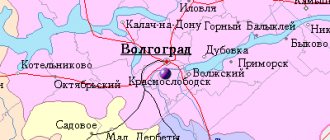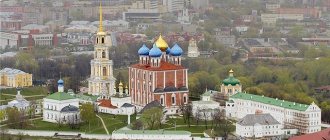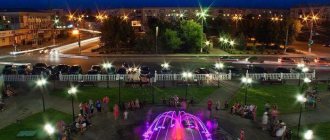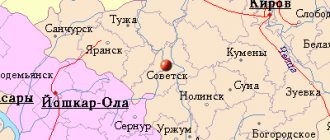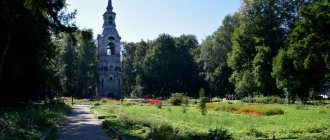| City Zhirnovsk Flag | Coat of arms |
| A country | Russia, Russia |
| Subject of the federation | Volgograd regionVolgograd region |
| Municipal district | Zhirnovsky |
| urban settlement | Zhirnovskoe |
| Coordinates | 50°58′49″ n. w. 44°46′51″ E. d. / 50.98028° n. w. 44.78083° E. d. / 50.98028; 44.78083 (G) [www.openstreetmap.org/?mlat=50.98028&mlon=44.78083&zoom=12 (O)] (Z)Coordinates: 50°58′49″ N. w. 44°46′51″ E. d. / 50.98028° n. w. 44.78083° E. d. / 50.98028; 44.78083 (G) [www.openstreetmap.org/?mlat=50.98028&mlon=44.78083&zoom=12 (O)] (I) |
| Based | in the 18th century |
| Former names | Zhirnoye (XVIII century—1954), Zhirnovsky (1954—1958) |
| City with | 1958 |
| Square | 27 km² |
| Center height | 120 |
| Population | ↘16,060[1] people (2016) |
| Names of residents | Zhirnovtsy, Zhirnovets; Zhirnovchane, Zhirnovchanin, Zhirnovchanka |
| Timezone | UTC+3 |
| Telephone code | +7 84454 |
| Postal codes | 403790-403793 |
| Vehicle code | 34, 134 |
| OKATO code | [classif.spb.ru/classificators/view/okt.php?st=A&kr=1&kod=18212501 18 212 501] |
| Official site | [admzhirn.ru/n.ru] |
| Zhirnovsk Moscow |
| Volgograd Zhirnovsk |
Zhirnovsk
- a city (since 1958) in the Volgograd region of Russia, the administrative center of the Zhirnovsky district and the Zhirnovsky urban settlement.
Population - 16,060[1] people. (2016)
Story
The exact date of foundation has not been established. Presumably the village of Zhirnoye was founded in the middle of the 18th century. The first settlers were Mordovians and fugitive Russians from the Serbian district, in which the estates of Prince Kurakin were located. The first huts were first built on the eastern side of Zhirnoye Lake. Later, the settlers considered the territory 5 versts north along the Medveditsa River a more convenient place for economic activity and living. The village belonged to the Nizhne-Dobrinsky volost of the Kamyshinsky district of the Saratov province[2].
By 1862, there were 235 households in the village, in which 748 males and 770 females lived. All residents considered themselves Great Russians of the Orthodox faith, and some of them were of the Old Believer persuasion. The village had one church, a sheepfold and one mill[2].
Since 1935, the village of Zhirnoye was part of the Lemeshkinsky district of the Stalingrad region (later the Stalingrad region)[3]. During the years of collectivization, the Komsomolets collective farm was organized. The collective farm was low-income. In the 1930s, the population of the village gradually declined[2].
A new impetus for the development of the settlement was the discovery of an oil field. In 1949, the first oil well was drilled on the outskirts of the village of Zhirnoye[2]. In 1950, the village of Zhirnoye and the Zhirnovsky village council were included in the Medveditsky district. In 1950, the village of Zhirnoye was transformed into the working settlement of Zhirnovsky
.
In the same year, the village of Kurakino and the village of Neftyanikov were included within the boundaries of the working village of Zhirnovsky. In 1958, the working settlement of Zhirnovsky was transformed into a city of regional subordination and was given the name the city of Zhirnovsk
. In 1959, the center of the Medveditsky district was moved from the working-class village of Linevo to the city of Zhirnovsk, and the district was renamed Zhirnovsky[4]
Zhirnovsk
(Volgograd region)
OKATO code:
18212501
Founded: Urban settlement since:
1954
City since:
1958 City of district subordination (Zhirnovsky district, Volgograd region)
Center:
Zhirnovsky district
The city was formerly called:
| Bold | 1954 | |
| Zhirnovsky | 1954 | 1958 |
| Telephone code (reference phone) | |
| 84454***** | |
| 844542**** | |
Deviation from Moscow time, hours:
0
Geographic latitude:
50°59′
Geographic longitude:
44°46′
Altitude above sea level, meters:
120 Sunrise and sunset times of the Sun and Moon in the city of Zhirnovsk
Economy
Oil and gas production, asphalt concrete plant, transport, SpetsNefteTrans, JSC RITEK, bakery, food processing plant, 2 workshops have sunk into oblivion. Before coming to the region, Zhirnovsk was the center of oil production in the region. The Nizhnevolzhsky branch of the drilling rig today remains one of the main city-forming enterprises.
Thanks to oil production, the city is relatively comfortable, and its residents have a higher standard of living compared to many other regional centers of the Volgograd region. In the city there are 2 stores of the federal chain “Pokupochka”, a store of the “Pyaterochka” chain, four stores of the federal chain “Magnit”, a store of the “Radezh” chain, a “TIS” computer equipment store and others. There is also an information agency “Vilgan” in Zhirnovsk, which includes the information newspaper “Zhirnovskie Advertising” and radio “Vilgan”.
Map
| Zhirnovsk: maps |
Zhirnovsk: photo from space (Google Maps) Zhirnovsk: photo from space (Microsoft Virtual Earth)
| Zhirnovsk. Nearest cities. Distances in km. on the map (in brackets along roads) + direction. Using the hyperlink in the distance , you can get the route (information courtesy of the AutoTransInfo website) | |||
| 1 | Linevo | 11 (13) | YU |
| 2 | Rudnya | 25 (23) | SW |
| 3 | Krasny Yar | 31 (39) | YU |
| 4 | Kalininsk | 60 (71) | WITH |
| 5 | Bald Mountains (Saratov region) | 63 (95) | WITH |
| 6 | Krasnoarmeysk | 65 (254) | IN |
| 7 | Yelan | 72 (78) | Z |
| 8 | Kotovo | 74 (83) | YU |
| 9 | Samoilovka (Saratov region) | 76 (103) | Z |
| 10 | Danilovka | 83 (151) | SW |
| 11 | Rovnoe (Saratov region) | 92 (290) | IN |
| 12 | Tatishchevo (Saratov region) | 96 (187) | NE |
| 13 | Svetly (Saratov region) | 96 (191) | NE |
| 14 | Sokolovy (Saratov region) | 98 (184) | NE |
| 15 | Petrov Val | 99 (120) | YU |
| 16 | Atkarsk | 100 (182) | WITH |
| 17 | Privolzhsky (Saratov region) | 101 (202) | NE |
| 18 | Saratov | 107 (174) | NE |
| 19 | Kamyshin | 109 (142) | SE |
| 20 | Engels | 110 (189) | NE |
| 21 | Nikolaevsk | 117 (156) | SE |
a brief description of
Located in the southern part of the Volga Upland, on the left bank of the river. Medveditsa (Don basin), 27 km north of the railway. Medveditsa station, 320 km north of Volgograd.
Territory (sq. km): 92
Information about the city of Zhirnovsk on the Russian Wikipedia site
Historical sketch
Until 1954 - the village of Zhirnoye. Since 1954 - the working village of Zhirnovsky. City of Zhirnovsk since 1958
The primary name is presumably associated with oil seeps.
Economy
Mining of oil and gas. Asphalt concrete plant, bakery, food processing plant.
Main enterprises
OIL PRODUCTION INDUSTRY
Zhirnovsky oil refining department of OJSC "Lukoil-Nizhnevolzhskneft"
403760, Volgograd region, Zhirnovsky district, Zhirnovsk, st.
Matrosova, 20 Offers:
oil, natural gas
Culture, science, education
Museum of History and Local Lore.
| Population by year (thousands of inhabitants) | |||||||
| 1959 | 9.9 | 2000 | 19.1 | 2010 | 16.1 | 2017 | 15.9 |
| 1970 | 14.7 | 2001 | 19.0 | 2011 | 16.9 | 2018 | 15.7 |
| 1979 | 15.7 | 2003 | 17.8 | 2012 | 16.7 | 2019 | 15.5 |
| 1989 | 16.8 | 2005 | 17.2 | 2013 | 16.6 | 2020 | 15.5 |
| 1992 | 17.5 | 2006 | 16.9 | 2014 | 16.4 | 2021 | 15.3 |
| 1996 | 19.0 | 2007 | 16.7 | 2015 | 16.2 | ||
| 1998 | 19.2 | 2008 | 16.5 | 2016 | 16.1 | ||
Attractions
- Temple of the Holy Spirit-Comforter
- Zhirnovsky District House of Culture
- Park of Culture and Recreation
- Komsomolsky Park
- Monument to fellow countrymen
- 40th Anniversary of Victory Park
- Cross on the TV Tower
- Blue Mountain tract
- Monument to V.I. Lenin (Near RDK)
Socio-cultural sphere
The city has: a nursing home, a hospital town, a sanatorium, and an air/railway ticket office.
Education
Kindergartens
- Preschool educational institution MDS No. 2 “Topolek”, Zhirnovsk
- Preschool educational institution MDS No. 3 “Solnyshko”, Zhirnovsk
- Preschool educational institution MDS No. 4 “Zvezdochka”, Zhirnovsk
- Preschool educational institution MDS No. 5 “Ivushka”, Zhirnovsk
- Preschool educational institution MDS No. 6 “Malyshok”, Zhirnovsk
- Preschool educational institution MDS of general developmental type No. 7 “Rodnichok”, Zhirnovsk
- Preschool educational institution MDS No. 8 “Semitsvetik”, Zhirnovsk
- Preschool educational institution MDS of combined type No. 9 “Golden Key”, Zhirnovsk
Schools
- Municipal educational institution "Secondary school No. 1"
- Municipal educational institution "Secondary school No. 2"
- Municipal educational institution "Secondary school No. 3"
- Municipal educational institution "Secondary School No. 4" (Closes in the summer of 2015, students disperse to the remaining schools.)
- Municipal educational institution Evening (shift) secondary school in Zhirnovsk.
Secondary special educational institutions
- Zhirnovsky Pedagogical College
- Zhirnovsky Oil College
- Training
Institutions of additional education
- School of the Arts
- Center of children's creativity
Culture
Zhirnovsky District House of Culture
In 1959, the Neftyanik Palace of Culture was built in the young city. At that time, there were no such Palaces of Culture in any district of the region. Based on the results of his work in 2006, he was recognized as the best in the review competition “Club of the Year of the Volgograd Region”. Today in the RDC more than 40 specialists are engaged in cultural and leisure work. In total, there are 57 groups operating in the House of Culture, with 987 participants. In 2014 they renamed and hung a new sign to now become RDK (District House of Culture)
There is also a stadium, a sports and recreation center, libraries, and a local history museum.
Fat.RU
The city of Zhirnovsk is located on the territory of the Volgograd region, 40 km from the border with the Saratov region, in the southern part of the Volga Upland on both sides of the Medveditsa River (a tributary of the Don). The nearest railway station - Medveditsa is 27 km away, from Zhirnovsk to the regional center (Volgograd) - 320 km.
The city was founded in the mid-18th century by Mordovian, Russian and Ukrainian settlers as the village of Zhirnoye. According to folk legends, the founders of the village were fugitives from the Serdobsky district of the Penza province, who fled from the estate of Prince Kurakin. At first they settled on the eastern side of the lake, which abounded in “fat” fish. For unknown reasons, a few years later they left this place and moved five miles higher along the Medveditsa River, settling opposite the village of Kurakino. This is how the village of Zhirnoye appeared in the Kamyshin district of the Nizhne-Dobrinsky volost, which was located 120 versts from Saratov and at the same distance from Kamyshin.
There are several versions of the origin of the name of the village, each of which may be correct. The name of the village could have been given in honor of Zhirnaya Lake with “fat” fish, the Zhirnaya Poruba ravine, or Zhirnaya Gora, where robbers lived in past centuries and where the government-owned horse-drawn road ran along which convoys were sent from Nikolaevka and Kamyshin to Saratov. There is also a version that the village got its name because of the greasy oil stains that often appeared in past centuries on the surface of local reservoirs. Geologist A.V. had his own version with scientific overtones. Kirsanova: the village owes its name to the millstone - quartz sandstone with iron impurities, which the first settlers mined under Mount Zhirnaya. This strong sandstone was used to make millstones. At that time, wind, hand and water-driven mills were in use in Russia, and millstones were the main element of the mill. The same opinion was expressed by teacher of the Zhirnovsky Oil College A.I. Gudkova. Another variant of the name of the village is based on the surname of the first settler - ZhirnOv.
In 1949, the first oil well was drilled on the outskirts of the village of Zhirnoye, from which active development of the Zhirnovskoye oil and gas field began. The population of the villages of Zhirnoye and Kurakino increased and since 1954 Zhirnoye was renamed the village of Zhirnovsky, and in 1958, on the basis of it and the village of Kurakino, the city of Zhirnovsk was formed, which in 1959 became the center of the Zhirnovsky district. The active development of the city of Zhirnovsk has practically not preserved historically valuable architectural monuments. It is known for certain that the district cultural center and Komsomolsky Park were built on the site where the rural cemetery was previously located. An attempt by local residents in the 50s of the last century to prevent the liquidation of this cemetery was suppressed. Already in the 90s, a church was built on the outskirts of Komsomolsky Park, in the courtyard of which a memorial cross was installed.
From the 50s of the last year until the beginning of this century, city-forming enterprises of the oil and gas industry - Zhirnovskoe OGPD and Zhirnovskoe UBR - successfully operated in the city. There were also lamp factories, a bakery, and an asphalt-bitumen plant. As a result of the collapse of the USSR, the city and region were left without lamp factories, sausage and canning factories, meat processing plants, children's holiday camps, collective farms and state farms. Their place was taken by small farms, private bakeries, transport companies and a trading network of large grocery supermarkets and clothing pavilions, expanding every year.
And as a result of administrative reforms and the modern policy of reorganization in the oil and gas industry, Zhirnovsk and the region were left without city-forming enterprises, a sanatorium, and a football team. Only the city's educational institutions were able to avoid collapse, but two of them were affected by the reorganization process: in 2015, school No. 4 was closed - all classes of the school were transferred to school No. 3, PU-18 became part of the Zhirnovsky Oil College.
Now the majority of the working-age population of Zhirnovsk is forced to work in other regions on a rotational basis or move for permanent residence to more prosperous cities, and the once oil-donor region has turned into a subsidized agricultural region in a zone of risky agriculture with a chronic budget deficit.
Currently, the Zhirnovsky urban settlement of the Volgograd region includes: the city of Zhirnovsk (industrial zone, Kolkhozka, central part, Zagorodnaya, Solnechny, Topolki, Zarechny, Kurakino) with the adjacent residential areas Sosnovy, Rodnikovy.
Share news:
- 3
- 3
Shared
Notes
- ↑ 123
www.gks.ru/free_doc/doc_2016/bul_dr/mun_obr2016.rar Population of the Russian Federation by municipalities as of January 1, 2016 - ↑ 1234
[gis.miroznai.ru/Trip/Pages/ShowSubject.aspx?sbjid=4328&templId=16 Zhirnovsk city | Past] - [volga.rusarchives.ru/atd/atd2.pdf History of the administrative-territorial division of the Stalingrad (Lower Volga) region. 1928–1936: Directory] / Compiled by: D. V. Buyanov, N. S. Lobchuk, S. A. Noritsyna. - Volgograd: Volgograd Scientific Publishing House, 2012. - 575 p. — ISBN 978-5-90608-102-5.
- [volga.rusarchives.ru/atd/2.18.doc 2.18. Zhirnovsky; Zhirnovsk] // [volga.rusarchives.ru/atd.shtml History of the administrative-territorial division of the Volgograd (Stalingrad) region. 1936−2007: Directory. in 3 volumes] / Compiled by: D. V. Buyanov, T. I. Zhdankina, V. M. Kadashova, S. A. Noritsyna. - Volgograd: Peremena, 2009. - T. 2. - ISBN 978-5-9846166-8-3.
- ↑ 123456
[gis.miroznai.ru/Trip/Pages/ShowSubject.aspx?sbjid=4328&templId=16 City of Zhirnovsk. History of the settlement]. Retrieved January 1, 2016. [www.webcitation.org/6eDTQM2fv Archived from the original on January 1, 2016]. - [demoscope.ru/weekly/ssp/rus59_reg2.php All-Union Population Census of 1959. The size of the urban population of the RSFSR, its territorial units, urban settlements and urban areas by gender] (Russian). Demoscope Weekly. Retrieved September 25, 2013. [www.webcitation.org/6GDOghWC9 Archived from the original on April 28, 2013].
- [demoscope.ru/weekly/ssp/rus70_reg2.php All-Union Population Census of 1970 The size of the urban population of the RSFSR, its territorial units, urban settlements and urban areas by gender.] (Russian). Demoscope Weekly. Retrieved September 25, 2013. [www.webcitation.org/6GDOiMstp Archived from the original on April 28, 2013].
- [demoscope.ru/weekly/ssp/rus79_reg2.php All-Union Population Census of 1979 The size of the urban population of the RSFSR, its territorial units, urban settlements and urban areas by gender.] (Russian). Demoscope Weekly. Retrieved September 25, 2013. [www.webcitation.org/6GDOjhZ5L Archived from the original on April 28, 2013].
- [demoscope.ru/weekly/ssp/rus89_reg2.php All-Union Population Census of 1989. Urban population]. [www.webcitation.org/617x0o0Pa Archived from the original on August 22, 2011].
- ↑ 12345678
www.MojGorod.ru/volgorad_obl/zhirnovsk/index.html People's encyclopedia “My City”. Zhirnovsk - [www.perepis2002.ru/ct/doc/1_TOM_01_04.xls All-Russian Population Census 2002. Volume. 1, table 4. Population of Russia, federal districts, constituent entities of the Russian Federation, districts, urban settlements, rural settlements - regional centers and rural settlements with a population of 3 thousand or more]. [www.webcitation.org/65AdCU0q3 Archived from the original on February 3, 2012].
- [www.gks.ru/bgd/regl/b08_14t/IssWWW.exe/Stg/ug/12.htm Cities of the Volgograd region (number of inhabitants - estimate as of January 1, 2008, thousand people)]. Retrieved June 10, 2016. [www.webcitation.org/6iAPnDR9L Archived from the original on June 10, 2016].
- [www.gks.ru/bgd/regl/B09_109/IssWWW.exe/Stg/d01/tabl-21-09.xls Number of permanent population of the Russian Federation by cities, urban-type settlements and districts as of January 1, 2009]. Retrieved January 2, 2014. [www.webcitation.org/6MJmu0z1u Archived from the original on January 2, 2014].
- volgastat.gks.ru/wps/wcm/connect/rosstat_ts/volgastat/resources/fb8a0f004fe3ed6b85a4edd8c740ec4f/t1_14.pdf All-Russian Population Census 2010. Population of urban districts, municipal districts, urban and rural settlements, urban and rural settlements of the Volgograd region
- [www.gks.ru/free_doc/doc_2012/bul_dr/mun_obr2012.rar Population of the Russian Federation by municipalities. Table 35. Estimated resident population as of January 1, 2012]. Retrieved May 31, 2014. [www.webcitation.org/6PyOWbdMc Archived from the original on May 31, 2014].
- [www.gks.ru/free_doc/doc_2013/bul_dr/mun_obr2013.rar Population of the Russian Federation by municipalities as of January 1, 2013. - M.: Federal State Statistics Service Rosstat, 2013. - 528 p. (Table 33. Population of urban districts, municipal districts, urban and rural settlements, urban settlements, rural settlements)]. Retrieved November 16, 2013. [www.webcitation.org/6LAdCWSxH Archived from the original on November 16, 2013].
- [www.gks.ru/free_doc/doc_2014/bul_dr/mun_obr2014.rar Table 33. Population of the Russian Federation by municipalities as of January 1, 2014]. Retrieved August 2, 2014. [www.webcitation.org/6RWqP50QK Archived from the original on August 2, 2014].
- [www.gks.ru/free_doc/doc_2015/bul_dr/mun_obr2015.rar Population of the Russian Federation by municipalities as of January 1, 2015]. Retrieved August 6, 2015. [www.webcitation.org/6aaNzOlFO Archived from the original on August 6, 2015].
- taking into account the cities of Crimea
- [www.gks.ru/free_doc/doc_2016/bul_dr/mun_obr2016.rar Population of the Russian Federation by municipalities as of January 1, 2016. Table “31. Population of cities and towns by federal districts and constituent entities of the Russian Federation as of January 1, 2016.” RAR archive (1.0 MB)]
Excerpt characterizing Zhirnovsk
- You love him? “Yes,” Natasha whispered. -What are you crying about? “I’m happy for you,” said Princess Marya, having completely forgiven Natasha’s joy for these tears. – It won’t be soon, someday. Think about what happiness it will be when I become his wife and you marry Nicolas. – Natasha, I asked you not to talk about this. We'll talk about you. They were silent. - But why go to St. Petersburg! - Natasha suddenly said, and she quickly answered herself: - No, no, this is how it should be... Yes, Marie? This is how it should be... Seven years have passed since the 12th year. The troubled historical sea of Europe has settled into its shores. It seemed quiet; but the mysterious forces that move humanity (mysterious because the laws determining their movement are unknown to us) continued to operate. Despite the fact that the surface of the historical sea seemed motionless, humanity moved as continuously as the movement of time. Various groups of human connections formed and disintegrated; the reasons for the formation and disintegration of states and the movements of peoples were prepared. The historical sea, not as before, was directed by gusts from one shore to another: it seethed in the depths. Historical figures, not as before, rushed in waves from one shore to another; now they seemed to be spinning in one place. Historical figures, who previously at the head of troops reflected the movement of the masses with orders of wars, campaigns, battles, now reflected the seething movement with political and diplomatic considerations, laws, treatises... Historians call this activity of historical figures reaction. Describing the activities of these historical figures, who, in their opinion, were the cause of what they call the reaction, historians strictly condemn them. All famous people of that time, from Alexander and Napoleon to m me Stael, Photius, Schelling, Fichte, Chateaubriand, etc., are subject to their strict judgment and are acquitted or condemned, depending on whether they contributed to progress or reaction. In Russia, according to their description, a reaction also took place during this period of time, and the main culprit of this reaction was Alexander I - the same Alexander I who, according to their descriptions, was the main culprit of the liberal initiatives of his reign and the salvation of Russia. In real Russian literature, from a high school student to a learned historian, there is not a person who would not throw his own pebble at Alexander I for his wrong actions during this period of his reign. “He should have done this and that. In this case he acted well, in this case he acted badly. He behaved well at the beginning of his reign and during the 12th year; but he acted badly by giving a constitution to Poland, making the Holy Alliance, giving power to Arakcheev, encouraging Golitsyn and mysticism, then encouraging Shishkov and Photius. He did something wrong by being involved in the front part of the army; he acted badly by distributing the Semyonovsky regiment, etc.” It would be necessary to fill ten pages in order to list all the reproaches that historians make to him on the basis of the knowledge of the good of humanity that they possess. What do these reproaches mean? The very actions for which historians approve of Alexander I, such as: the liberal initiatives of his reign, the fight against Napoleon, the firmness he showed in the 12th year, and the campaign of the 13th year, do not stem from the same sources - the conditions of blood , education, life, which made Alexander’s personality what it was - from which flow those actions for which historians blame him, such as: the Holy Alliance, the restoration of Poland, the reaction of the 20s? What is the essence of these reproaches? The fact that such a historical person as Alexander I, a person who stood at the highest possible level of human power, is, as it were, in the focus of the blinding light of all the historical rays concentrated on him; a person subject to those strongest influences in the world of intrigue, deception, flattery, self-delusion, which are inseparable from power; a face that felt, every minute of its life, responsibility for everything that happened in Europe, and a face that is not fictitious, but living, like every person, with its own personal habits, passions, aspirations for goodness, beauty, truth - that this face , fifty years ago, not only was he not virtuous (historians do not blame him for this), but he did not have those views for the good of humanity that a professor now has, who has been engaged in science from a young age, that is, reading books, lectures and copying these books and lectures in one notebook. But even if we assume that Alexander I fifty years ago was mistaken in his view of what is the good of peoples, we must involuntarily assume that the historian judging Alexander, in the same way, after some time will turn out to be unjust in his view of that , which is the good of humanity. This assumption is all the more natural and necessary because, following the development of history, we see that every year, with every new writer, the view of what is the good of humanity changes; so that what seemed good appears after ten years as evil; and vice versa. Moreover, at the same time we find in history completely opposite views on what was evil and what was good: some take credit for the constitution given to Poland and the Holy Alliance, others as a reproach to Alexander. It cannot be said about the activities of Alexander and Napoleon that they were useful or harmful, because we cannot say for what they are useful and for what they are harmful. If someone does not like this activity, then he does not like it only because it does not coincide with his limited understanding of what is good. Does it seem good to me to preserve my father’s house in Moscow in 12, or the glory of the Russian troops, or the prosperity of St. Petersburg and other universities, or the freedom of Poland, or the power of Russia, or the balance of Europe, or a certain kind of European enlightenment - progress, I must admit that the activity of every historical figure had, in addition to these goals, other, more general goals that were inaccessible to me. But let us assume that so-called science has the ability to reconcile all contradictions and has an unchanging measure of good and bad for historical persons and events. Let's assume that Alexander could have done everything differently. Let us assume that he could, according to the instructions of those who accuse him, those who profess knowledge of the ultimate goal of the movement of mankind, order according to the program of nationality, freedom, equality and progress (there seems to be no other) that his current accusers would have given him. Let us assume that this program was possible and drawn up and that Alexander would act according to it. What would then happen to the activities of all those people who opposed the then direction of the government - with activities that, according to historians, were good and useful? This activity would not exist; there would be no life; nothing would have happened. If we assume that human life can be controlled by reason, then the possibility of life will be destroyed. If we assume, as historians do, that great people lead humanity to achieve certain goals, which consist either in the greatness of Russia or France, or in the balance of Europe, or in spreading the ideas of revolution, or in general progress, or whatever it may be, it is impossible to explain the phenomena of history without the concepts of chance and genius. If the goal of the European wars at the beginning of this century was the greatness of Russia, then this goal could be achieved without all the previous wars and without an invasion. If the goal is the greatness of France, then this goal could be achieved without revolution and without empire. If the goal is the dissemination of ideas, then printing would accomplish this much better than soldiers. If the goal is the progress of civilization, then it is very easy to assume that, besides the extermination of people and their wealth, there are other more expedient ways for the spread of civilization. Why did it happen this way and not otherwise? Because that's how it happened. “Chance made the situation; genius took advantage of it,” says history. But what is a case? What is a genius? The words chance and genius do not mean anything that really exists and therefore cannot be defined. These words only denote a certain degree of understanding of phenomena. I don't know why this phenomenon happens; I don't think I can know; That’s why I don’t want to know and say: chance. I see a force producing an action disproportionate to universal human properties; I don’t understand why this happens, and I say: genius.
